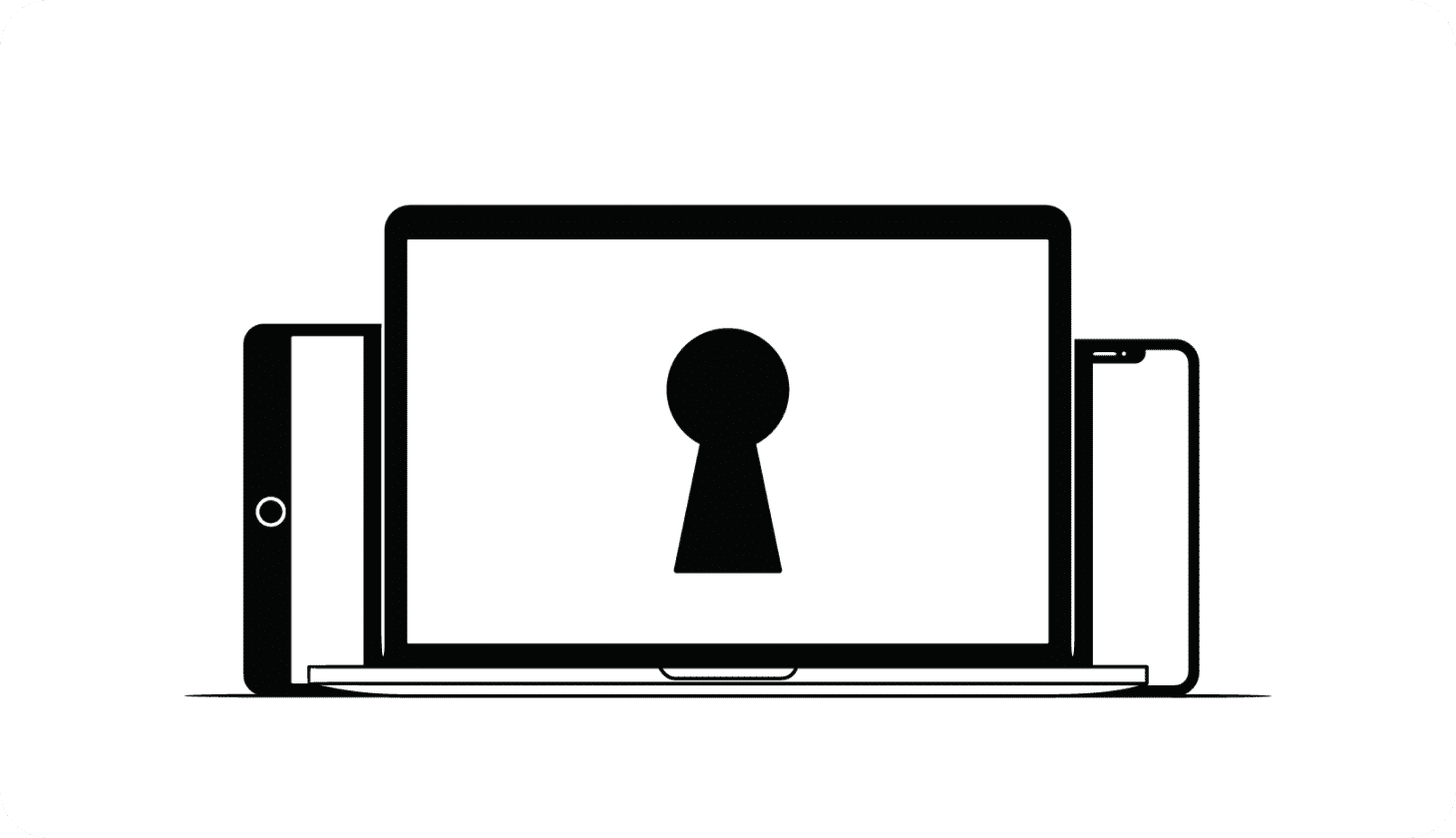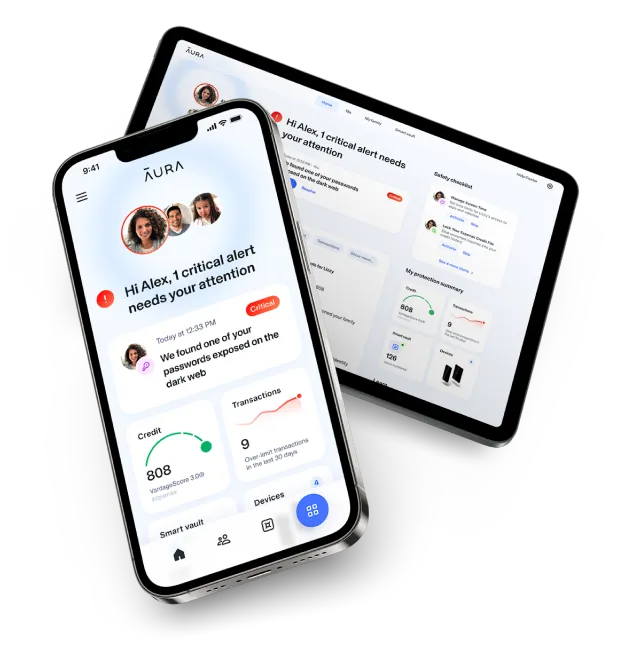In this article:
How To Protect Yourself From Hackers Right Now
Hackers use advanced tools and personal information leaked in data breaches to target victims — but you can stay safe by following a few security measures.
Hackers use advanced tools and personal information leaked in data breaches to target victims — but you can stay safe by following a few security measures.

What’s the Best Defense Against Hackers?
Using strong passwords, antivirus protection, and two-factor authentication (2FA), as well as ignoring unexpected messages and links are some of the best ways you can prevent hacking. Unfortunately, it’s impossible to prevent all cyber attacks from reaching you. And the ones that make it through are getting more sophisticated and deadly.
In 2024 alone, Americans lost over $3.5 billion to scams originating online, according to the Federal Trade Commission (FTC).
To stay safe online, you need to take a proactive approach to digital security and learn the common warning signs of hacks, phishing, and other cyber threats.
{{show-toc}}
How To Prevent Hacking and Stay Safe Online
Hacking occurs when cybercriminals gain unauthorized access to your devices, data, or online accounts — enabling them to find and exploit your personal and financial information.
While some online scammers use malware and device vulnerabilities to gain access to your data, others target human vulnerabilities through phishing scams and other social engineering techniques.
In other words, hackers can either hack your device or they can hack your identity.
That’s why protecting yourself against hackers requires both the right cybersecurity setup and scam-spotting know how. Here’s what you can do to stay safe:
1. Use strong and unique passwords on all online accounts
Online services store everything from your passwords to your Social Security number (SSN), bank account details, and credit card numbers. If you use weak passwords or your credentials are compromised in a data breach, this can give hackers access to any sensitive personal data you’ve entrusted to an online account.
When securing your accounts, make sure you use passwords that are:
- Long. Passwords that are longer than 10 characters take significantly longer to hack using methods such as a brute force attack.
- Complex. Avoid easy-to-guess passwords and instead combine letters, numbers, and symbols — for example, L0rD0fth3R1nG$!.
- Unique. Don’t repeat passwords (or variations of the same password), as this can give hackers access to multiple accounts after a single data breach.
Pro tip: A password manager makes your complex passwords easy to access when you need them. Aura’s secure password manager creates and stores strong passwords, giving you access to them with a single master password.
2. Enable multifactor authentication using an authenticator app
Passwords can be leaked in data breaches or broken by talented hackers. Two-factor authentication (2FA/MFA) is an additional security measure that requires a special one-time-use code or other factor to access your accounts.
While most people opt for a 2FA code sent to their phone or email, these can be intercepted by hackers. Instead, the most secure method is to use an authenticator app, such as Authy or MIcrosoft or Google Authenticator.
Examples of how to enable 2FA:
- Set up 2FA for your Google Account. Open your Google Account and select Security. Then select 2-Step Verification and follow the steps.
- Set up 2FA for your Apple ID. In your iPhone Settings, select your name/account. Then select Sign-In & Security and Turn On Two-Factor Authentication.
💡 Related: How Does Two-Factor Authentication Work? →
3. Install antivirus software on all of your devices
Hackers use malicious software — such as malware, trojans, ransomware, and spyware — to access your devices, steal and hold your data ransom, or even spy on you. Malware is especially dangerous if you have a jailbroken or rooted mobile device.
While most devices include some form of antivirus protection, dedicated antivirus software often does a better job. This is especially true on Windows and Android devices, which are more heavily targeted by hackers. (There’s no such thing as antivirus for iPhones, as Apple doesn’t allow them).
4. Use a virtual private network when browsing in public
Hackers can access your home network’s router — or spy on you when you use public Wi-Fi networks (such as at coffee shops, hotels, or airports) — to steal sensitive data or infect your devices with malware.
A VPN encrypts your data so that anyone, including hackers and your internet service provider (ISP), can’t see what you’re doing. Aura’s VPN also gives you access to over 100 virtual locations, so you can access geo-fenced content.
5. Turn on automatic updates for your apps and operating systems
Vulnerabilities in outdated software can give hackers access to your phone, computer, or accounts. Automatic software updates patch security flaws and vulnerabilities before hackers can exploit them.
Here’s how to enable automatic updates on:
6. Set up Safe Browsing tools to warn you of phishing links and fake websites
Many hackers send text messages or create pop-up ads that redirect you to fake websites in hopes that you'll enter your passwords or payment details. These malicious sites often mimic login pages for your bank, or companies such as Amazon and Walmart.
Safe Browsing tools in your web browser (or tools like Aura) can warn you if you’re entering a potentially dangerous or lookalike website before you enter your password or other details.
💡 Related: What To Do If You Click On a Phishing Link →
7. Limit the personal information you share online
Cybercriminals can extract information found on public social media accounts, in Google searches, and via your online footprint to tailor their attacks or guess your passwords and security questions.
You can reduce the personal information available about you online by:
limit the information that hackers can discover about you online by:
- Limit the information you share in online profiles. Don’t provide phone numbers, home addresses, middle names, or other sensitive information. It’s also a good idea to tighten your social media privacy settings.
- Delete unused or old accounts. These can be hacked and used against you or your contacts.
- Use the “guest checkout” when shopping online. This can prevent your credit card number or other payment details from being leaked if the website is hacked.
- Remove your data from data broker lists. These companies scrape and sell profiles of your online information. You can request removals manually, or use an automatic data broker removal service.
- Provide fake information for some accounts. Including a fake birthdate or other information makes it harder for hackers to “connect the dots” with your leaked data.
{{hacker-view-widget}}
8. Regularly backup data in a secure location
If you get hacked, cybercriminals may try to corrupt your data or hold it ransom until you pay them. Keeping regular backups ensures you can safely ignore hackers’ demands or factory restore your device.
There are many cloud services you can use to backup your files, but it’s also a good idea to regularly use a physical hard drive to store backups as well.
Pro tip: Update your backup email and phone number on your online accounts to make it easier to regain access to them after a hack.
9. Learn the warning signs of a phishing attack or hack
Phishing emails, texts, and other messages are a common tactic used by hackers to trick you into giving up sensitive information, clicking on malicious links, or calling scammers directly. Any unsolicited message should be a warning sign of a potential hacking attempt.
If you’re unsure whether a message is legitimate or not, look for these warning signs of a phishing attack:
- Strange or mismatched sender details. Check that messages are coming from official phone numbers, email accounts, and social media accounts.
- Threats, prizes, or any sense of urgency to act. Scammers try to get you to act without thinking by threatening fines and jail time or promising huge rewards if you act immediately.
- Poor design, grammar, and other details. Don’t ignore poor or outdated logos and design elements, broken English, and strange grammar or formatting.
💡 Related: How To Prevent Phishing Attacks →
10. Monitor your sensitive information in data breaches and the Dark Web
One of the most obvious warning signs that you’ve been hacked is if you receive notifications stating that your bank account, passwords, or sensitive personal information have been compromised.
Along with regularly reviewing your bank account and credit statements, you should sign up for identity monitoring and alerts.
Leaked or compromised passwords and financial details often end up on hacker forums on the Dark Web. Aura’s free Dark Web scanner can tell you if your accounts are at risk and need to be updated.
What To Do If You Think You’ve Been Hacked
If you think you've been hacked or victimized by cybercrime, you need to act quickly to minimize the damage that hackers can cause:
- Disconnect compromised devices from the internet, and run antivirus software. A hacked or malware-infected device could exploit other devices on the network. Take your device offline right away, and scan it with an antivirus program.
- Regain control of your accounts, and change your passwords. Follow each service’s process for regaining access (usually by clicking on “forgot my password” located on the login screen). Make sure you're using strong and unique passwords,.
- Freeze your credit with all three bureaus. Block hackers from taking out loans or opening accounts in your name by freezing your credit with all three bureaus — Experian, Equifax, and TransUnion.
- Contact your bank and any other impacted company. If your bank accounts or credit cards were compromised, contact your bank's fraud department and report the situation.
- File an official report with the Federal Trade Commission (FTC) and the FBI. Contacting the FTC is an essential step to investigating fraud and identity theft. Depending on your situation, visit ReportFraud.ftc.gov or IdentityTheft.gov to file your complaint. You might also want to file a police report or submit a report to the FBI’s Internet Crime Complaint Center (IC3).
- Consider signing up for identity theft protection. Get identity theft protection to monitor your sensitive information and alert you to suspicious activity.
The bottom line: Hackers have more ways than ever to target you. Unless you don’t use the internet, there’s a good chance that your passwords and sensitive information are available to hackers. Download Aura today and shield yourself from online scammers →
The Bottom Line: Hackers Are Getting More Sophisticated – Aura Can Help
Hackers have become very adept at breaking into online accounts, and new schemes and technologies emerge daily.
Aura takes the weight off your shoulders with a single, easy-to-use app that provide round-the-clock access to advanced digital security tools, award-winning protection, 24/7 U.S.-based customer support, and optional $1 million identity theft insurance coverage.
Editorial note: Our articles provide educational information for you to increase awareness about digital safety. Aura’s services may not provide the exact features we write about, nor may cover or protect against every type of crime, fraud, or threat discussed in our articles. Please review our Terms during enrollment or setup for more information. Remember that no one can prevent all identity theft or cybercrime.











